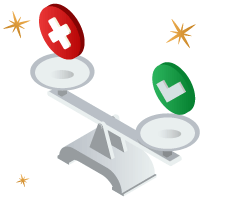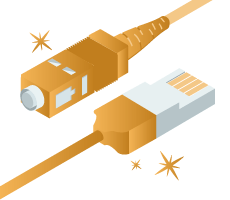
Get Superfast Fibre Broadband With Selectra!

ADSL, or Asymmetric Digital Subscriber Line, is one of the earliest internet access forms available to the public. How does it stack up against modern fibre-optic connections? What speeds can you expect, and what exactly is ADSL broadband? Read our full ADSL broadband guide to find out more!
Find Out if You Can Get Superfast Fibre Broadband in One Free Call!
Rated ⭐⭐⭐⭐ on Trustpilot So You Know Selectra Customers Get Broadband Advice You Can Trust!
Looking to Switch Broadband Providers?
We're currently closed but please leave us your number and we'll give you a free call as soon as we're open!

ADSL stands for Asymmetric Digital Subscriber line, which is a sub-type of DSL (Digital Subscriber Line) technology. In short, ADSL uses copper cables to provide you with a stable and continuous internet connection. These copper lines are also used for your phone line, and so in some cases, you December require a DSL filter (also known as a DSL splitter) to ensure that these two services do not interfere with each other.
Though ADSL uses the same cables as traditional dial-up connections, unlike dial-up, ADSL broadband provides a continuous connection to the data network, allowing for faster speeds and a more stable connection than its predecessor.
ADSL broadband is one of the most widespread forms of internet connection worldwide due to the prominence of copper-cable technology. The bit rate and bandwidth of ADSL are asymmetric, meaning that there is a greater emphasis on download speed, rather than upload speed. This means that ADSL is suited to those who use their broadband for downloads and streaming but December not be appropriate for intensive data uploads.
Additionally, due to how widespread the copper cable network is, ADSL is available in most homes. Though copper cables result in relatively low speeds (up to a maximum download speed of 24 Mbps with ADSL 2+), this also means that on average ADSL plans are cheaper than those of other connection forms, such as fibre, siro or satellite broadband.
This combination of affordability and wide availability makes ADSL an attractive choice for those who are on a budget, live in rural areas and have yet to be reached by NBI (National Broadband Ireland), or otherwise have light internet usage.
Find Out if You Can Get Superfast Fibre Broadband in One Free Call!
Rated ⭐⭐⭐⭐ on Trustpilot So You Know Selectra Customers Get Broadband Advice You Can Trust!
Looking to Switch Broadband Providers?
We're currently closed but please leave us your number and we'll give you a free call as soon as we're open!

The biggest competitor to ADSL broadband is fibre. Fibre uses fibre optic cables to connect properties directly to their network distributor (full-fibre) or to connect to a local exchange in the street, from which copper cables then run to the home (part-fibre). The nature of fibre-optic cables allows for a significantly faster data-exchange rate, resulting in vastly improved speeds. Let’s take a look at a few more pros and cons
Ultimately fibre is a faster and more reliable service due to the infrastructure and materials that are in use being modern and well supported. That being said, if you do not need a superfast connection, or live in an area where fibre speeds are poor or are otherwise unavailable, then ADSL is certainly a viable choice.
Mobile speeds, such as with mobile broadband and 4G/5G technology have been getting faster and faster. So fast in fact, it's approaching the same speeds as the fibre broadband you'll get at home. Although it varies between different parts of the country, you might be able to get faster and cheaper mobile broadband using a 5G network than you would using ADSL!
How fast is your internet? Know how fast your internet is important for making sure you're getting what your paying for. It's also useful so you can see why your internet might not be enough for your day to day tasks. IIf your provider fails repeatedly to give you the speeds advertised, you can complain to Comreg. The best way to find out how fast your broadband is is to run a speed test which will give you your download and upload speeds!
Check Out Our Internet Speed Test!
Find Out if You Can Get Superfast Fibre Broadband in One Free Call!
Rated ⭐⭐⭐⭐ on Trustpilot So You Know Selectra Customers Get Broadband Advice You Can Trust!
Looking to Switch Broadband Providers?
We're currently closed but please leave us your number and we'll give you a free call as soon as we're open!
VDSL (Very high-speed Digital Subscriber Line) lines use the same copper wires as traditional ADSL, but manage the data exchange at a significantly higher rate. This results in download speeds of up to 52 Mbps (double ADSL), and upload speeds of 16 Mbps. VDSL2 can even provide download speeds of up to 300 Mbps, making it a solid choice for HD streaming, working from home, and other intensive online tasks.
Similarly to ADSL, VDSL does suffer from speed loss the further away from the street cabinet your property is, but this rate degrades at a significantly slower rate than ADSL, allowing for a strong connection regardless of the distance. Some VDSL connections can even be part-fibre, allowing for even greater stability and speed.
To identify if you have ADSL or VDSL, you can complete one of the four steps

Though ADSL broadband is no longer the preferred type of broadband in Ireland, it is still a long way off being retired. Many companies now focus on fibre or wireless connections, but a few companies such as Pure Telecom, Vodafone, Eir and Sky still offer limited ADSL services, with price points ranging from €20-€35 depending on seasonal and introductory offers.
As each company has varying capabilities and coverage areas, in order to find what deals are compatible with your property, you will need to head over to each provider's respective website, and either input your full address, or your Eircode. This should result in a range of compatible deals appearing on the next screen, of which ADSL will be one of them as long as it is a viable option for your property.
Find Out if You Can Get Superfast Fibre Broadband in One Free Call!
Rated ⭐⭐⭐⭐ on Trustpilot So You Know Selectra Customers Get Broadband Advice You Can Trust!
Looking to Switch Broadband Providers?
We're currently closed but please leave us your number and we'll give you a free call as soon as we're open!
Yes. As ADSL uses the same copper cables as a phone line, you will need a phone line for this internet type to work. This does not, however, mean that you must have a landline phone.
DSL stands for Digital Subscriber Line, and is a group of technologies including ADSL and VDSL that transmit data digitally via traditional telephone lines. All forms of this broadband type have a DSL modem and a DSL cable that is connected to the phone line in your home.
ADSL achieves speeds of up to around 6-8 Mbps. ADSL 2 and ADSL+ however is a more modern version of the original technology and can achieve speeds up to 24 Mbps, with less speed degradation through the copper wire length than the original ADSL broadband type.
Find out more about our offers from energy, broadband and waste collection providers!
The services and products mentioned on this website may only represent a small selection of the options available to you. Selectra encourages you to carry out your own research and seek advice if necessary before making any decisions. We may receive commission from selected partner providers on sales of some products and/or services mentioned within this website. Our website is free to use, and the commission we receive does not affect our opinion or the information we provide.
Looking for the Best Broadband Deal in 2025?